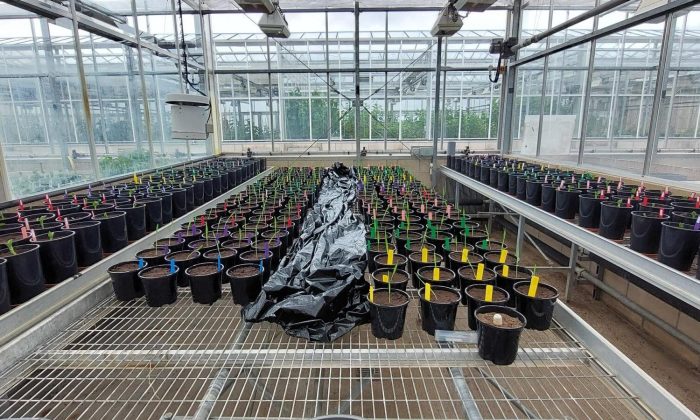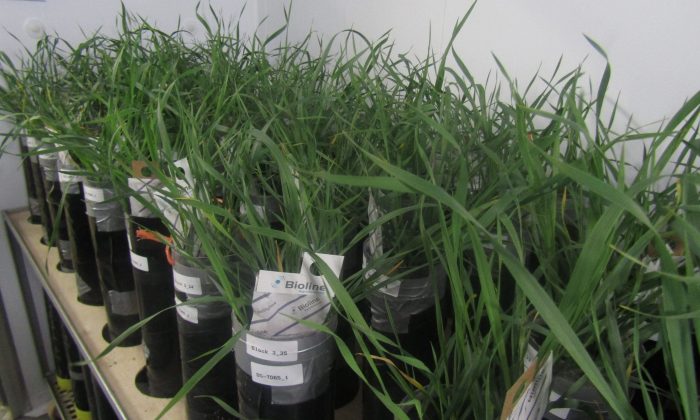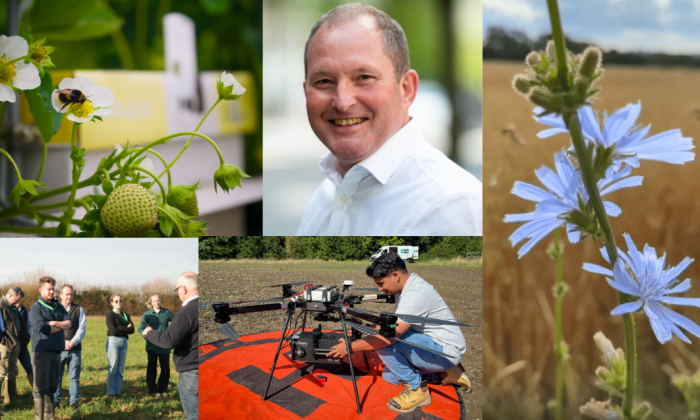By Paddy Tarbuck, Agri-Food Sustainability Specialist, UK Agri-Tech Centre
On International Biodiversity Day, we are highlighting the central role of biodiversity in our food systems.
Biodiversity in decline
Farmland covers around 70% of the UK and thus needs to support a wide range of wildlife and habitats. Indeed, farming and food production is reliant on biodiversity through the provision of valuable ecosystem services that boost production including pollination, pest control, nutrient cycling and ultimately, more resilient farming systems – no biodiversity, no farming, no food.
In the UK, nearly one in six species are threatened with extinction and 60% of farmland species are now in decline (State of Nature Report, 2023). This plight is largely due to the post-war rapid intensification of agriculture, namely, overdependence on chemical inputs and widespread loss of wildlife-friendly habitats on farms such as hedgerows.
Globally, the ecological outlook is also stark, with wildlife populations declining by 69% since 1970. Risks of future extinction and habitat loss will continue to increase in all global warming scenarios without urgent and deep emission reductions.
Global policy outlook
To tackle biodiversity loss and halt the decline of species, a global landmark agreement for nature was struck by nearly 200 countries at COP15, the UN Biodiversity Conference, in Montreal. The resulting Kunming-Montreal Global Biodiversity Framework sets out an agenda for protecting at least 30% of the Earth’s ecosystems by 2030 (see more information on this landmark agreement here).
The UK, as one of the signatories, aligns with these global targets through the Environment Act in 2021. This legislation sets out to halt the decline in biodiversity loss by 2030 and increase it by at least 10% by 2042 and is the core legislative framework for the recently introduced Biodiversity Net Gain policy.
Farm actions
So, how can farmers and the agri-food industry support biodiversity and ensure food security?
In England, Defra’s new Environmental Land Management Scheme (ELMS), and associated Sustainable Farming Incentives (SFIs) and Nature Recovery and Countryside Stewardship Plus (CS+), set out a list of actions to empower nature friendly farming practices. The common goal is the protection and enhancement of existing habitats, in addition to the creation of new habitats.
The uptake of SFI was initially slow, but continues to grow, with almost 14,000 agreements in place now. Recent studies have begun to demonstrate that ‘wildlife-friendly’ farming can in fact increase crop yields and net margins, particularly where those ‘difficult to farm areas’ have been intensified for ecological benefits.
The increase in beneficial predators and pollinators, through nature-friendly farming, can also drive the transition away from chemical farming to biological farming; reducing inputs, costs, environmental risks, and ultimately, strengthening the resilience of farm systems – a win-win for many farmers.
Supporting technologies
Despite increasing evidence to suggest that these sustainable farm actions are beneficial to both biodiversity and farm enterprises, every farm is different, and results from one study might not translate readily into all farming systems. There is a requirement to continue to innovate and equip farmers with the tools to empower decision making at the farm, industry, and policy level.
The UK Agri-Tech Centre is committed to the development of biodiversity monitoring technologies and has demonstrated this through its legacy ‘Biodiversity Monitoring 24/7’ project. This initiative combined digital biodiversity monitoring through bioacoustics, citizen science and machine learning methods, alongside in situ observations and surveys from an ecologist at Dorset Wildlife Trust, in a collective effort to align methods and approaches to measuring and monitoring biodiversity on-farm.
The project team continues to digitally monitor farmyard birds and pollinators with bioacoustics technology in situ across our network of satellite farms. Beyond ground-sensing technologies, there is growing application of remote sensing and earth satellite observation for mapping habitats and monitoring the protection and restoration of priority habitats.
There are also novel eDNA techniques that measure below ground biodiversity, rising in importance as demonstrated by a recent study, which found that soil is home to 59% of all life on Earth. These techniques could offer a unique insight into how agricultural practices interact with soil biology and ultimately, life on Earth.
Unlocking the potential of biodiversity innovation
We are seeing continuous research and development of biodiversity monitoring technologies, particularly in practical application and direct support to ecologists. However, more collaboration is required between the scientific community, innovators, finance sector, industry, and farmers to co-develop the next generation of tools to support a just transition to nature-friendly farming practices which is where we are open for collaboration.
Behavioural drivers for protecting and restoring biodiversity on-farm also need to be considered, particularly the impacts and risks of sustainable farm actions on yields and productivity. Providing effective financial flows into the development of farm infrastructure and rewards to farmers for sustainable farming practices is crucial for uptake of biodiversity initiatives.
Industry and government support can prove critical, in this instance, through the provision of premium payments for farmers, guaranteeing that natural capital is valued in equal measure to products and outputs. This is a key component of the new Taskforce on Nature-related Financial Disclosures (TNFD) that many industry players will need to comply to in the coming years.
Finally, we need to avoid overburdening farmers with data. They are already tasked with providing hundreds of different data points for commercial contracts, assurance schemes, regulation, compliance and the rest. We need to prioritise data interoperability across any novel monitoring technologies, ensuring that outputs are aligned with, and co-developed by, farmers, to maximise adoption and guide landowners and farmers through this transition period.
The UK Agri-Tech Centre has invested in technologies to measure nature living on and around a network of farms. The technology measures pollinators and birds active on farms where biodiversity measures have been put in place, such as hedgerows, woodlands, wetlands, grass margins, beetle banks and catch crops.
- Working alongside Chirrup we plan to collect data on bird species that are active in the network using Dawn Chorus Recording devices.
- Partnering with Pollenize, we are collecting pollen samples from AI Beehives to monitor the crops, plants or trees that bees are pollinating.
- We are also collecting data on nocturnal pollinators including moths using UV Light boxes with camera recording devices.
The data collected across our network of farms in these projects will allow us to see where on-farm biodiversity measures are working or need improvement and will provide evidence to show the nature-positive activities in the farming community.
The UK Agri-Tech Centre offers a complete life-cycle of support, driving agri-tech innovation and adoption through access to world-class facilities, expert knowledge and business support, saving you time and accelerating your progress. We strengthen the connections between science, business and funders to accelerate research development business development and tackling the agri-industry’s most critical challenges. We are trusted to provide leadership and guidance to progress transformational change for people and the planet while stimulating economic growth.
Read Part 1 of this biodiversity series



